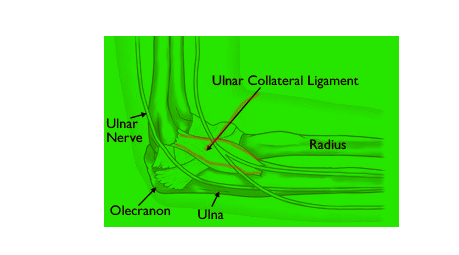Quick Overview
Ulnar Collateral Ligament, often abbreviated as UCL, is a critical ligament situated on the inner or medial side of the elbow joint. It connects the humerus (the upper arm bone) to the ulna (the larger of the two forearm bones), forming a triangular structure that provides stability to the elbow during various movements, especially throwing motions.

Table of Contents
Anatomy of Ulnar Collateral Ligament
The Ulnar Collateral Ligament comprises three distinct bundles or bands which include;
- Anterior Bundle (Medial Collateral Ligament): This bundle is the most crucial for preventing excessive valgus stress on the elbow during activities like throwing. It runs from the medial epicondyle of the humerus to the medial aspect of the coronoid process of the ulna.
- Posterior Bundle (Transverse Ulnar Collateral Ligament): Situated behind the anterior bundle, the posterior bundle plays a role in stabilizing the elbow during the late cocking and early acceleration phases of throwing.
- Oblique (or Accessory) Bundle: The oblique bundle provides additional support to the UCL and helps resist valgus forces.
Read also Occipital Triangle (Omoclavicular Triangle)
Function of Ulnar Collateral Ligament
The UCL has two main functions:
1- Stability: The Ulnar Collateral Ligament helps to stabilize the elbow and prevent it from moving too far outward (valgus stress).
2- Guidance: The UCL helps to guide the elbow through its range of motion.
Ulnar Collateral Ligament Injury
A UCL injury is a common injury among athletes who participate in overhead throwing sports, such as baseball, softball, and tennis. UCL injuries can also occur in people who do not participate in sports, but who frequently perform activities that involve repetitive overhead arm movements, such as painting or carpentry.
Types of UCL Injuries
Ulnar Collateral Ligament injuries can be vary in severity and can range from minor strains to complete tears. Common types of UCL injuries include:
- UCL Sprain: A mild injury involving stretching or slight tearing of the ligament.
- Partial Tear: A more significant injury where a portion of the ligament is torn.
- Complete Tear (UCL Rupture): A severe injury where the ligament is completely torn, often requiring surgical intervention.
Signs and Symptoms of UCL Injuries
The most common symptom of a Ulnar Collateral Ligament injury is pain on the inner side of the elbow. Other symptoms may include:
- Swelling on the inner side of the elbow
- Difficulty throwing or hitting a ball
- Weakness in the elbow
- Instability of the elbow
- A popping or clicking sound in the elbow when moving it
Diagnosis of UCL Injuries
A doctor can diagnose a UCL injury by performing a physical examination and asking about the patient’s medical history and symptoms. The doctor may also order imaging tests, such as an X-ray or MRI, to confirm the diagnosis and assess the severity of the injury.
Treatment and Rehabilitation
Treatment for UCL injuries varies depending on the severity of the injury but may include;
- Rest and Immobilization: Mild cases may heal with rest, bracing, and physical therapy.
- Surgery (Tommy John Surgery): Severe UCL tears often require surgical reconstruction.
- Rehabilitation: Physical therapy plays a crucial role in regaining strength and function in the affected arm.
Prevention of UCL Injury
There are a few things you can do to prevent a UCL injury, including:
- Warming up before participating in physical activity
- Strengthening the muscles around the elbow
- Using proper form when throwing a ball
- Avoiding activities that aggravate the elbow
Questions
Q: What is the difference between a UCL sprain and a UCL rupture?
A UCL sprain is a stretching or tearing of the ligament, while a UCL rupture is a complete tear of the ligament. UCL sprains are typically less severe than UCL ruptures and may heal on their own with rest, ice, compression, and elevation (RICE). UCL ruptures typically require surgery to repair the torn ligament.
Q: How long does it take to recover from a UCL injury?
The recovery time for a UCL injury depends on the severity of the injury. Mild UCL sprains may heal within a few weeks, while more severe UCL sprains and UCL ruptures may take several months to heal.
Q: Can I still play sports after a UCL injury?
Yes, you can still play sports after a UCL injury, but it is important to follow your doctor’s instructions and gradually return to activity. It is also important to wear a brace or other supportive device to protect your elbow from further injury.
Q: How can I prevent a UCL injury?
There are a few things you can do to prevent a UCL injury, including:
1- Warming up before participating in physical activity
2- Strengthening the muscles around the elbow
3- Using proper form when throwing a ball
4- Avoiding activities that aggravate the elbow
Q: What are the risks of surgery for a UCL injury?
Surgery for a UCL injury is generally safe and effective. However, there is a small risk of complications, such as infection, nerve damage, and stiffness.
